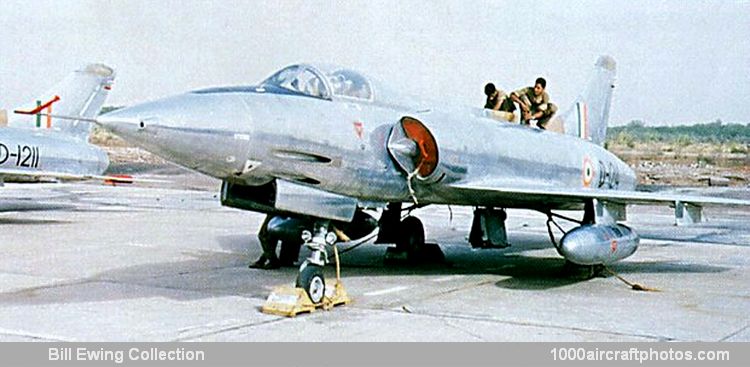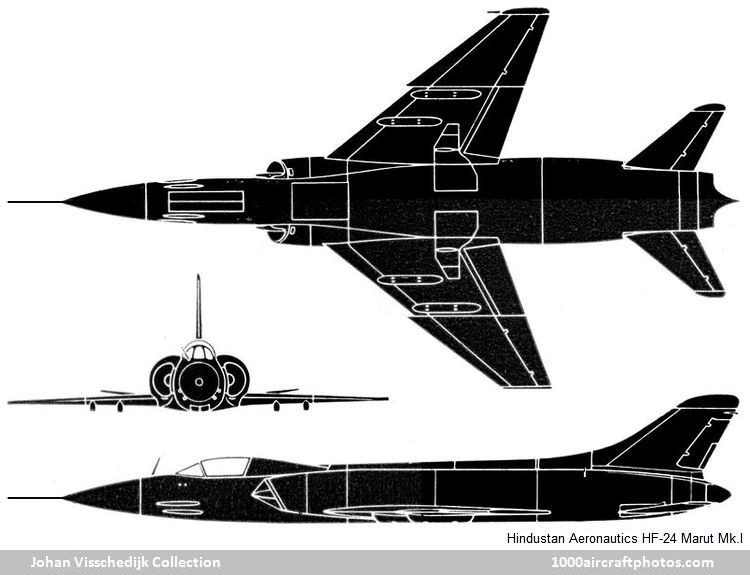12/31/2019. Remarks by Johan Visschedijk: "The Marut (Wind Spirit) was India's first indigenous combat aircraft, the eventual result of a 1950 decision by the Indian government to develop its own combat aircraft. Development of the Marut (Wind Spirit) was started in 1956 by the Hindustan Aircraft Limited (HAL, since October 1 1964 known as Hindustan Aeronautics Limited). Leading the development team was the German designer Kurt Tank, well-known for the wartime Focke-Wulf aircraft, assisted by German and Indian engineers.
An unpowered two-seat full-scale wooden flying model of the HF-24, designated X-241, was flight tested extensively during 86 flights. It flew for the first time on March 21, 1959, and was normally released from its tow-plane at a height of 12,000 to 15,000 ft (3,658 to 4,572 m).
Powered by two 4,850 lb (2,200 kg) st Bristol Siddeley Orpheus 703 non-afterburning turbojets (license-built by Hindustan Aeronautics), the first Marut Mk.I prototype was flown on June 17, 1961, followed by the second prototype in October 1962.
Due to the power limitations of the Orpheus the intended high-performance interceptor role changed to ground attack. Armament comprised four 1.18 in (30 mm) Aden Mk.2 cannon in the nose plus a retractable Matra Type 103 pack in the lower fuselage aft of nose wheel unit containing fifty 2.68 in (68 mm) rockets. Four 1,000 lb (454 kg) bombs, other ordnance or drop-tanks could be carried on attachments under the wings.
The first of eighteen pre-production Marut Mk.I ground attack fighters flew in March 1963, and four were delivered to the Indian Air Force on May 10, 1964, followed by another ten on later dates. The remaining four were retained by HAL for trials and development. Designated Marut Mk.IA, one had afterburners fitted to the Orpheus 703 engines in 1966, two similar equipped aircraft were designated Marut Mk.IR. The fourth, designated Marut Mk.IBX, was sent to Egypt in mid-1966 to serve as a flying engine test bed, one of the Orpheus 703s being replaced by an Helwan EI-300 turbojet, an E-300 turbojet. In this form it flew for the first time on March 29, 1967. The first of 112 production Marut Mk.Is was flown on November 15, 1967.
A two-seat tandem trainer version was also developed, designated Marut Mk.IT. Since the departure of the German design team in 1967, development of this (and other) versions was done by an all-Indian design team under HAL chief designer S C. Das. This version had full dual controls, it retained much of the operational equipment of the Marut Mk.I, although the four Aden cannon were usually reduced to two, while the retractable rocket pack was removed permit the installation of the second seat. Two prototypes were built (serialed BD-888 and BD-889), and flown by wing-commander R.D. Sahni, Chief Test Pilot of the Bangalore Division of HAL, the first had its maiden flight on April 30, 1970. A batch of twelve Marut Mk.ITs ended the production of the HF-24."


